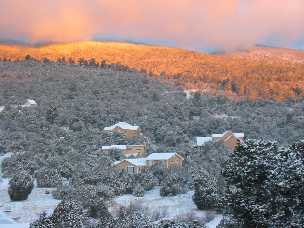 Cedar
Crest,
Cedar
Crest,New Mexico
Back Yard Birds
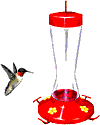

Our Former BackYard - 120 Species
| Our "Back Yard" |
Birding Calendar |
Yard List |
Story of a
Cotton- wood Seed |
| Birding
the Manzanos
and Manzanitas |
Rosy-Finches
of Sandia Crest |
Birding
the Sandias |
Check
List: Birds of Sandia and Manzanita Mountains (PDF) |

|
All
photos below were taken from
inside the windows of our home with Canon A40 and Kowa 77 mm
scope. For
information
and pictures of this digiscopic
equipment,
click here.
Click on
images for full
screen view
The territory we considered our "Backyard" is a
piņon-juniper
savannah and woodland at 6960 to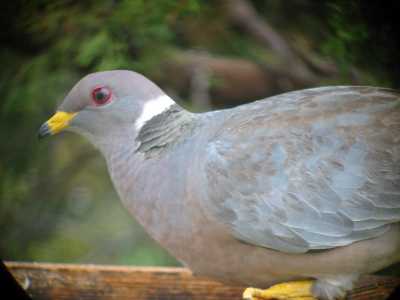 7010 feet elevation, on
7010 feet elevation, on 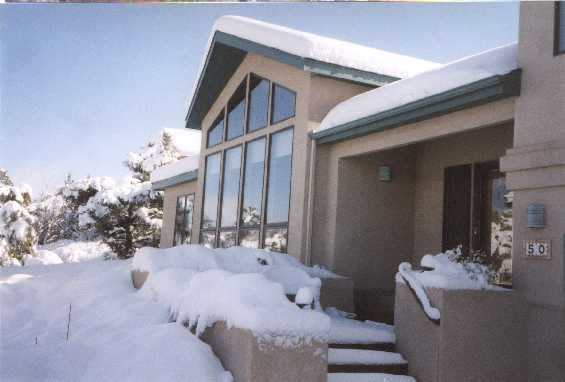 the
eastern slope of the Sandia Mountains. The Ventana del Sol
subdivision includes
55 acres of undeveloped "common ground" that contains about a mile of
paved road, two miles of hiking trails, a large dry arroyo, and a
sizable grassland patch. We include birds seen not only in
our
backyard, but also seen in and from the common ground. In
addition to juniper and piņon pine, we have scrubby Gambel
Oak,
a few Ponderosa Pines, a variety of grasses (Sideoats, Western
Wheat-grass and Blue Gramma predominate) and a profusion of
wildflowers. Heavy stands of Ponderosa are located just
adjacent
to our land, in
the Cibola National Forest. To make up for the lack of
the
eastern slope of the Sandia Mountains. The Ventana del Sol
subdivision includes
55 acres of undeveloped "common ground" that contains about a mile of
paved road, two miles of hiking trails, a large dry arroyo, and a
sizable grassland patch. We include birds seen not only in
our
backyard, but also seen in and from the common ground. In
addition to juniper and piņon pine, we have scrubby Gambel
Oak,
a few Ponderosa Pines, a variety of grasses (Sideoats, Western
Wheat-grass and Blue Gramma predominate) and a profusion of
wildflowers. Heavy stands of Ponderosa are located just
adjacent
to our land, in
the Cibola National Forest. To make up for the lack of 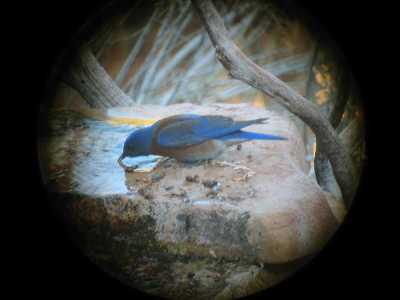 flowing streams
we have built two small ponds and maintain a variety of
flowing streams
we have built two small ponds and maintain a variety of feeders all
year 'round. We have a small low- maintenance "lawn" of Blue
Gramma and Buffalo Grass that separates us from the piņons
and
junipers, and have seeded our land with Rabbitbrush, pentstemons,
Apache Plume and other local flora. Above, left:
Scanned
image of our Great Room windows, which overlooked a pond and
feeders. Below, left: Male Western
Bluebird at our front
waterfall, FEB 2003. Above, right:
Band-tailed Pigeon at
feeder. Below, right: Front pond in winter. Stocked
with
top minnows (Gambusia or Mosquito Fish) Note stock tank
heater.
feeders all
year 'round. We have a small low- maintenance "lawn" of Blue
Gramma and Buffalo Grass that separates us from the piņons
and
junipers, and have seeded our land with Rabbitbrush, pentstemons,
Apache Plume and other local flora. Above, left:
Scanned
image of our Great Room windows, which overlooked a pond and
feeders. Below, left: Male Western
Bluebird at our front
waterfall, FEB 2003. Above, right:
Band-tailed Pigeon at
feeder. Below, right: Front pond in winter. Stocked
with
top minnows (Gambusia or Mosquito Fish) Note stock tank
heater. As much as we enjoyed viewing our familiar yard birds, some rarities appeared at times. Our most notable bird sightings were a Great Blue Heron (magnificently out of place atop our neighbor's garage), a
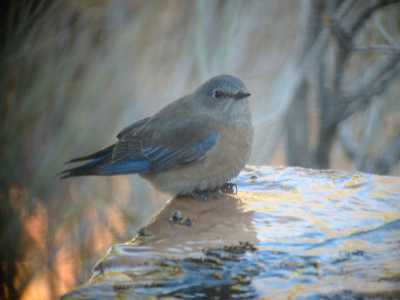
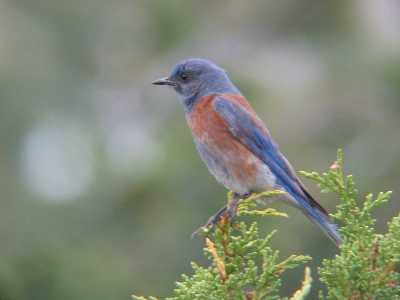 Hooded Warbler at our
pond, two spring visits
to our hummingbird feeders by Baltimore Oriole ,
exactly one
year apart, fly-overs by a Goshawk, a
Ferruginous Hawk,
and a pair of Golden Eagles, and several invasions
of
Cassin's Finches, Red Crossbills and Evening
Grosbeaks. Western and
Hepatic Tanagers have stopped by to sip nectar or drink at
our
waterfall. Lincoln's and Lark Sparrows are
welcome fall
visitors, and a Golden-crowned Sparrow stopped by
only once.
We waited until
2002 for our first Song Sparrow, which usually is
not found in
the piņon-juniper habitat. Still hoping for a White-throated
Swift fly-over, and Brewer's Sparrow ,
which must visit
our grasslands, but so far we see only Chipping Sparrows
in all
plumages. Yet we take great pleasure in the company of our
more
abundant local residents and winter visitors. Above:
left,
Male Western Bluebird atop a juniper; right, Female Western Bluebird at
our front waterfall, FEB 2003.
Hooded Warbler at our
pond, two spring visits
to our hummingbird feeders by Baltimore Oriole ,
exactly one
year apart, fly-overs by a Goshawk, a
Ferruginous Hawk,
and a pair of Golden Eagles, and several invasions
of
Cassin's Finches, Red Crossbills and Evening
Grosbeaks. Western and
Hepatic Tanagers have stopped by to sip nectar or drink at
our
waterfall. Lincoln's and Lark Sparrows are
welcome fall
visitors, and a Golden-crowned Sparrow stopped by
only once.
We waited until
2002 for our first Song Sparrow, which usually is
not found in
the piņon-juniper habitat. Still hoping for a White-throated
Swift fly-over, and Brewer's Sparrow ,
which must visit
our grasslands, but so far we see only Chipping Sparrows
in all
plumages. Yet we take great pleasure in the company of our
more
abundant local residents and winter visitors. Above:
left,
Male Western Bluebird atop a juniper; right, Female Western Bluebird at
our front waterfall, FEB 2003.
Birds that nested in boxes on our half acre home site are: Mountain Chickadee,
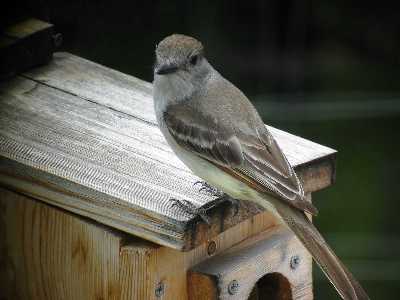 White-breasted Nuthatch,
White-breasted Nuthatch, 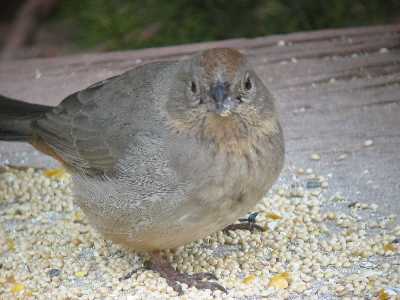 Juniper
Titmouse, Western Bluebird, Violet-green Swallow, and Ash-throated
Flycatcher. Our neighbors have additionally
attracted Kestrel and Bewick's Wren
to their nest
boxes. Say's Phoebe and House
Finch build nests
on light fixtures and under eaves. Cliff Swallows
once
attempted to nest in our upstairs porch, and Northern
(Red-shafted)
Flickers drill holes in exterior walls. Ladder-backed
Woodpeckers, Chipping Sparrows, Canyon and Spotted Towhees
nest in
the trees and under shrubs. In 2003 a Canyon Towhee made its
nest
in an open nest box that I had set out in hopes of attracting an American
Robin. Broad-tailed Hummingbirds,
Bushtits, American
Robins,
Juniper
Titmouse, Western Bluebird, Violet-green Swallow, and Ash-throated
Flycatcher. Our neighbors have additionally
attracted Kestrel and Bewick's Wren
to their nest
boxes. Say's Phoebe and House
Finch build nests
on light fixtures and under eaves. Cliff Swallows
once
attempted to nest in our upstairs porch, and Northern
(Red-shafted)
Flickers drill holes in exterior walls. Ladder-backed
Woodpeckers, Chipping Sparrows, Canyon and Spotted Towhees
nest in
the trees and under shrubs. In 2003 a Canyon Towhee made its
nest
in an open nest box that I had set out in hopes of attracting an American
Robin. Broad-tailed Hummingbirds,
Bushtits, American
Robins,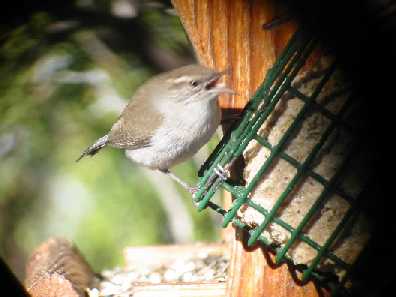 Black-headed
Grosbeaks, Pine
Black-headed
Grosbeaks, Pine 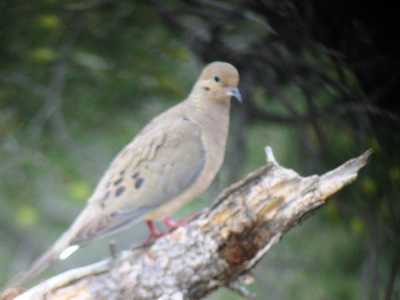 Siskins,
Lesser Goldfinches, Blue Grosbeaks, Mourning Doves,
Scrub Jays, American Crows, Virginia's Warbler,
Great Horned
Owl and a Cooper's Hawk all
nest near our homes.
Oh yes, European Starlings have
appropriated one
nest cavity, but we have sighted House Sparrows
only twice at
our feeders. Our only resident Roadrunner disappeared
during
the winter of 2000, and Lazuli Buntings nested here
at least
twice before 1999, but apparently not since then. I have
heard
migrating Sandhill Cranes and Canada
Geese overhead,
but have yet to spy them from our property. Above,
left:
Canyon Towhee at ground feeder, FEB 2002. Above, right:
Ash-throated Flycatcher at nest box. Lower, left: Mourning
Dove. Lower right: Bewick's Wren at
suet.
Siskins,
Lesser Goldfinches, Blue Grosbeaks, Mourning Doves,
Scrub Jays, American Crows, Virginia's Warbler,
Great Horned
Owl and a Cooper's Hawk all
nest near our homes.
Oh yes, European Starlings have
appropriated one
nest cavity, but we have sighted House Sparrows
only twice at
our feeders. Our only resident Roadrunner disappeared
during
the winter of 2000, and Lazuli Buntings nested here
at least
twice before 1999, but apparently not since then. I have
heard
migrating Sandhill Cranes and Canada
Geese overhead,
but have yet to spy them from our property. Above,
left:
Canyon Towhee at ground feeder, FEB 2002. Above, right:
Ash-throated Flycatcher at nest box. Lower, left: Mourning
Dove. Lower right: Bewick's Wren at
suet.
The surrounding forest offered opportunity to see other birds that were unlikely to visit our yard. The pond at Sandia Park
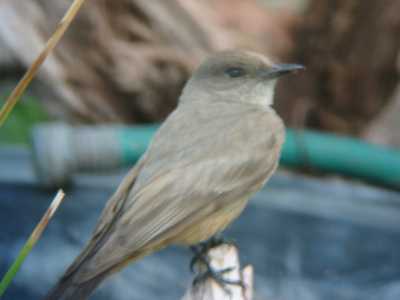 has attracted a variety of puddle
ducks as
well as Ring-necked Duck, and probably accounts for
our
fly-over ducks and the visiting Great Blue Heron .
Pygmy and Red-breasted Nuthatches abound
in the
Ponderosas and mixed conifers. Sandia Crest, at 10,678 feet
elevation, is an easy 14 mile drive up from our home, and has become
famous for its winter flock of all three species of
Rosy-Finch (see
link below). Pine Grosbeaks are regular but rare
winter
visitors to the Crest, which gets over 11 feet of snow in an average
year (compared to our 40 inches). Since 1999 the snow pack
has
been deficient; many springs have dried up, and in 2002
the pond in Sandia Park was dry for the first time in some 30
years. Our pond and waterfall were especially attractive to Say's
Phoebe (left).
has attracted a variety of puddle
ducks as
well as Ring-necked Duck, and probably accounts for
our
fly-over ducks and the visiting Great Blue Heron .
Pygmy and Red-breasted Nuthatches abound
in the
Ponderosas and mixed conifers. Sandia Crest, at 10,678 feet
elevation, is an easy 14 mile drive up from our home, and has become
famous for its winter flock of all three species of
Rosy-Finch (see
link below). Pine Grosbeaks are regular but rare
winter
visitors to the Crest, which gets over 11 feet of snow in an average
year (compared to our 40 inches). Since 1999 the snow pack
has
been deficient; many springs have dried up, and in 2002
the pond in Sandia Park was dry for the first time in some 30
years. Our pond and waterfall were especially attractive to Say's
Phoebe (left).
(Click
on thumbnails for full screen view)
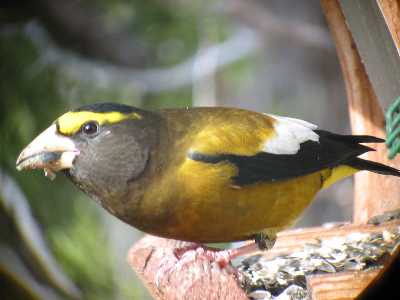 January-- Keep the yard
feeders
stocked and snow free for the innumerable Dark-eyed Juncos.
Expect visits from Pinyon and Steller's Jays and Abert's
Squirrel. Sharp-shinned Hawk very active at feeders.
Look
for White-winged and Slate-colored among the predominating Oregon and
Gray-headed Dark-eyed Junco subspecies. Hope that a few
White-crowned Sparrows stay on through the winter. Wandering
flocks of Evening Grosbeak (at our feeder, FEB 2003, left)
may
show up to gobble sunflower seed. We used to go up to Sandia
Crest every few days to stock the feeders for the Rosy-Finches.
January-- Keep the yard
feeders
stocked and snow free for the innumerable Dark-eyed Juncos.
Expect visits from Pinyon and Steller's Jays and Abert's
Squirrel. Sharp-shinned Hawk very active at feeders.
Look
for White-winged and Slate-colored among the predominating Oregon and
Gray-headed Dark-eyed Junco subspecies. Hope that a few
White-crowned Sparrows stay on through the winter. Wandering
flocks of Evening Grosbeak (at our feeder, FEB 2003, left)
may
show up to gobble sunflower seed. We used to go up to Sandia
Crest every few days to stock the feeders for the Rosy-Finches.
February-- At Sandia Crest, rosy-finches break down into smaller flocks of 4 or 5 to a dozen as
 the
month progresses. Be on watch for
the
month progresses. Be on watch for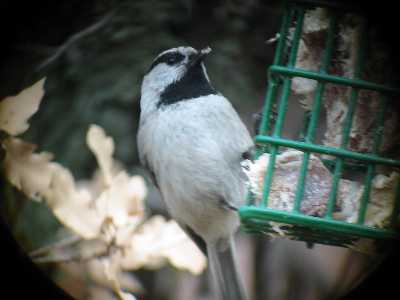 Merlins along the Crest Road.
Nights are long
and
cold.
Hope that snow cover is 100% all month. Find
Ponderosa twig
tips, stripped of bark, scattered in the snow on the forest floor,
evidence that cones are running low, and Abert's Squirrel is being
sustained by the cambium (Each squirrel drops about 45 twigs a day, an
indicator of their abundance). The
Slate-colored (Dark-eyed) Junco sometimes visits (left).
Marvel
at the survival skills of
tiny resident Bushtits, Mountain Chickadee (at suet, right),
Juniper Titmice and Canyon Towhees.
Merlins along the Crest Road.
Nights are long
and
cold.
Hope that snow cover is 100% all month. Find
Ponderosa twig
tips, stripped of bark, scattered in the snow on the forest floor,
evidence that cones are running low, and Abert's Squirrel is being
sustained by the cambium (Each squirrel drops about 45 twigs a day, an
indicator of their abundance). The
Slate-colored (Dark-eyed) Junco sometimes visits (left).
Marvel
at the survival skills of
tiny resident Bushtits, Mountain Chickadee (at suet, right),
Juniper Titmice and Canyon Towhees.March-- Red-tailed Hawks are courting early in the month. American Robin (perched in front yard, left) assemble in

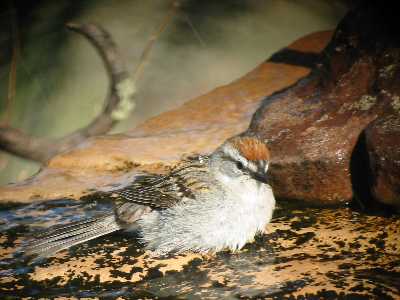 large
flocks. By the end of the month, most Rosy-Finches disappear
from
Sandia Crest, but a
few
linger into early
April. Days are perceptibly longer.
In the yard, Mountain Chickadees, White-breasted Nuthatches
and
Western Bluebirds inspect and claim nest boxes. Townsend's
Solitaires sing more vigorously before departing in early April.
On or about the first day of spring, expect arrival of Turkey
Vultures, Chipping Sparrows in fresh rufous caps
(one shown bathing front yard at waterfall, right)
and
territorial Say's Phoebes . Visit Hawk Watch in the Sandias.
large
flocks. By the end of the month, most Rosy-Finches disappear
from
Sandia Crest, but a
few
linger into early
April. Days are perceptibly longer.
In the yard, Mountain Chickadees, White-breasted Nuthatches
and
Western Bluebirds inspect and claim nest boxes. Townsend's
Solitaires sing more vigorously before departing in early April.
On or about the first day of spring, expect arrival of Turkey
Vultures, Chipping Sparrows in fresh rufous caps
(one shown bathing front yard at waterfall, right)
and
territorial Say's Phoebes . Visit Hawk Watch in the Sandias.April-- Broad-tailed Hummingbird wings whistle by the first of April. Take down the Rosy-Finch feeders by mid April.
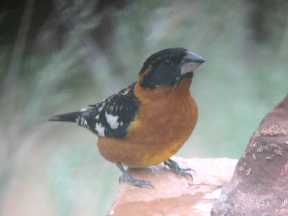
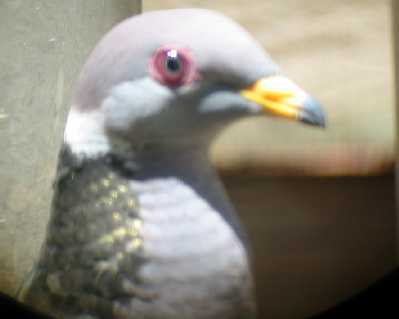 Scott's
Oriole claims territory in Three
Gun
Spring (Tres Pistolas) early in month.
Bullock's
Orioles and Western and Hepatic Tanagers arrive late in the month.
White-crowned Sparrows and Juncos depart by end of May. Black-headed
Grosbeak
(upper right) and Band-tailed Pigeons (upper
left, taken
through
screen on front window) appear at feeders-- add
cracked corn!
Violet-green Swallows and Ash-throated Flycatchers
(below,
right) try to displace Bluebirds
from nest boxes in the front yard. Look for Blue
Grouse on
the road to Santa Fe Baldy.
Say's
Phoebes (below, left, in front yard) are gathering nesting
materials before the end of the month.
Scott's
Oriole claims territory in Three
Gun
Spring (Tres Pistolas) early in month.
Bullock's
Orioles and Western and Hepatic Tanagers arrive late in the month.
White-crowned Sparrows and Juncos depart by end of May. Black-headed
Grosbeak
(upper right) and Band-tailed Pigeons (upper
left, taken
through
screen on front window) appear at feeders-- add
cracked corn!
Violet-green Swallows and Ash-throated Flycatchers
(below,
right) try to displace Bluebirds
from nest boxes in the front yard. Look for Blue
Grouse on
the road to Santa Fe Baldy.
Say's
Phoebes (below, left, in front yard) are gathering nesting
materials before the end of the month.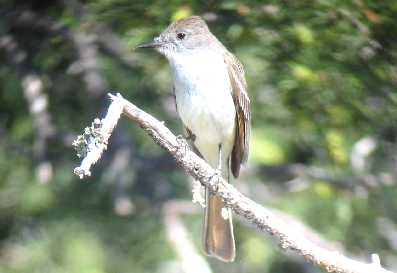
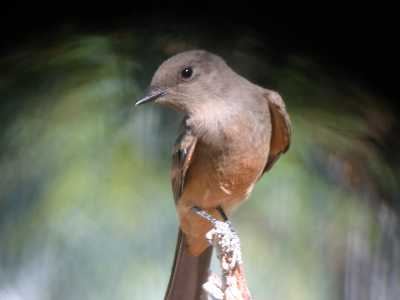
May-- Cordilleran Flycatcher and most of the forest birds are nesting. Plumbeous and Warbling Vireos are singing at
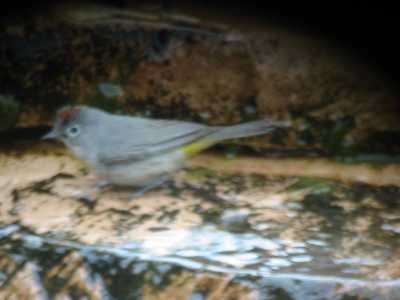
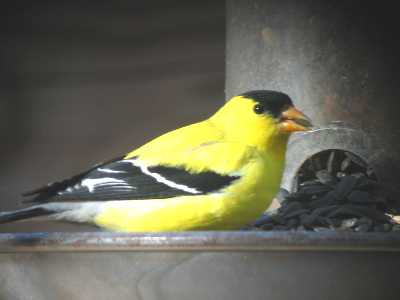 Cienega
Canyon Picnic Area off the Crest Road. Grace's Warblers are
high
in the Ponderosas, weaving in and out of the tips of the limbs, and Virginia's
Warblers (at waterfall in front yard, upper right) sing
everywhere
in
the forest. Black-throated Gray Warblers (also
visiting our
waterfall, at left, below) nest in the surrounding
piņon-juniper woodland. Goshawk sitting on eggs
early in
month. Evening Grosbeaks depart early in May after tolerating an uneasy
truce with the arriving Black-headed Grosbeaks at the yard feeders.
Northern Pygmy-owl, Northern Saw-whet and Flammulated Owl
begin
to call along the Crest Road around mid May, through next
month.
Wednesday morning bird walks begin in the Sandias, and
continue
into October. At upper left, American Goldfinch at
our
feeder
Cienega
Canyon Picnic Area off the Crest Road. Grace's Warblers are
high
in the Ponderosas, weaving in and out of the tips of the limbs, and Virginia's
Warblers (at waterfall in front yard, upper right) sing
everywhere
in
the forest. Black-throated Gray Warblers (also
visiting our
waterfall, at left, below) nest in the surrounding
piņon-juniper woodland. Goshawk sitting on eggs
early in
month. Evening Grosbeaks depart early in May after tolerating an uneasy
truce with the arriving Black-headed Grosbeaks at the yard feeders.
Northern Pygmy-owl, Northern Saw-whet and Flammulated Owl
begin
to call along the Crest Road around mid May, through next
month.
Wednesday morning bird walks begin in the Sandias, and
continue
into October. At upper left, American Goldfinch at
our
feeder 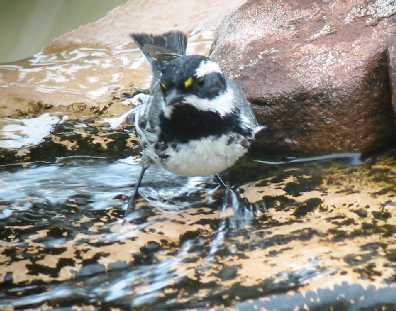 on May 24, 2003, in full
summer attire. Male Blue
on May 24, 2003, in full
summer attire. Male Blue 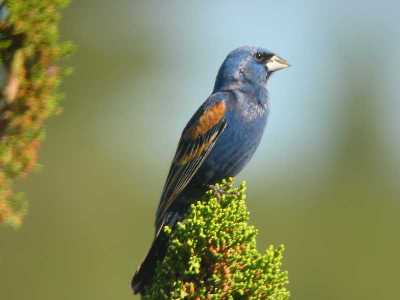 Grosbeak
on juniper in front yard, below to right.
Grosbeak
on juniper in front yard, below to right.June-- Blue Grosbeaks (male pictured at millet feeder, upper right) start their singing rather late, but after the second
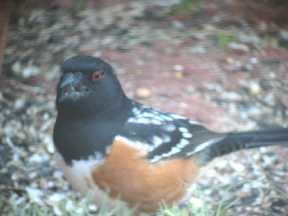
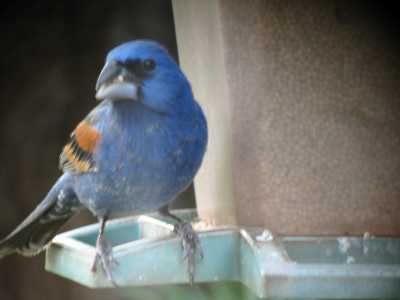 week
of June they sing incessantly throughout the day on territory,
continuing well into August. Meanwhile, the Black-headed
Grosbeaks nearly disappear from the feeders as they switch to a diet of
insects while raising
their young. Their fledgelings will join them at the feeders
later
in the month. Spotted Towhee (upper left)
eggs hatch
and
fledgelings are out by the beginning of the month. Hope for return of
nesting Lazuli
Buntings. Dusky Flycatchers arrive at Capulin Springs and at
10K
trailhead. Fire danger increases. Click to
see photos of slurry tankers fighting a lightning-caused fire southwest
of our home. While
not our hottest month, it is often the
driest, and the lack of clouds in the afternoon makes many days feel
hotter than in July or August. Our two waterfalls and two
bird
baths get lots of avian
week
of June they sing incessantly throughout the day on territory,
continuing well into August. Meanwhile, the Black-headed
Grosbeaks nearly disappear from the feeders as they switch to a diet of
insects while raising
their young. Their fledgelings will join them at the feeders
later
in the month. Spotted Towhee (upper left)
eggs hatch
and
fledgelings are out by the beginning of the month. Hope for return of
nesting Lazuli
Buntings. Dusky Flycatchers arrive at Capulin Springs and at
10K
trailhead. Fire danger increases. Click to
see photos of slurry tankers fighting a lightning-caused fire southwest
of our home. While
not our hottest month, it is often the
driest, and the lack of clouds in the afternoon makes many days feel
hotter than in July or August. Our two waterfalls and two
bird
baths get lots of avian 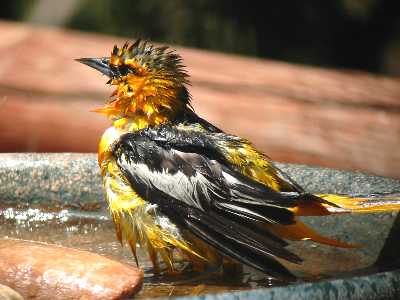 visitors.
Blue
pentstemmons
are in full bloom. The
visitors.
Blue
pentstemmons
are in full bloom. The 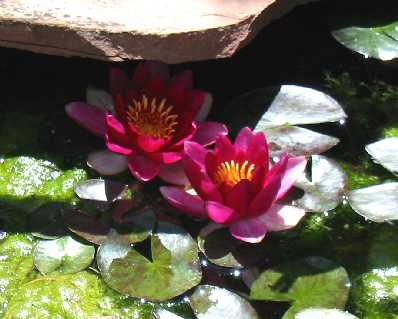 pond,
ablaze with water
lily blossoms
(lower right), allows a Bullock's Oriole (lower
left) to
forget his
pride.
pond,
ablaze with water
lily blossoms
(lower right), allows a Bullock's Oriole (lower
left) to
forget his
pride.July-- Rufous Hummingbirds (male, with tongue extended, upper right, and hovering at front feeder, lower right) arrive by the 4th. Some years,
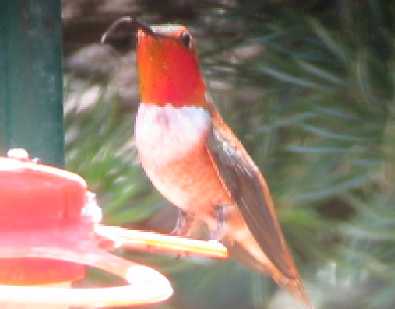
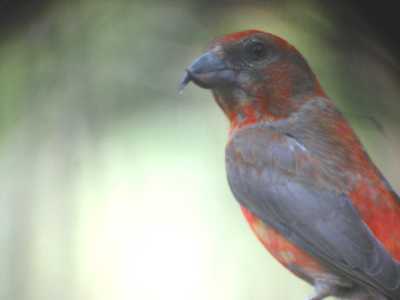 Red
Crossbill (male photographed at back feeder on July
1,
2003, upper left) breeds in nearby slopes. Ladder-backed
Woodpeckers (male, lower left, at suet feeder) are feeding
young.
Blue Grosbeaks continue to sing all day. July and
early
August are the best times to look for Black Swifts at Jemez Falls.
Monsoons begin before
mid month, afternoon clouds bring cooler nights, and grass turns green.
Pentstemmons bloom. Scott's Oriole may depart from
Tres
Pistolas Open Space before the
Red
Crossbill (male photographed at back feeder on July
1,
2003, upper left) breeds in nearby slopes. Ladder-backed
Woodpeckers (male, lower left, at suet feeder) are feeding
young.
Blue Grosbeaks continue to sing all day. July and
early
August are the best times to look for Black Swifts at Jemez Falls.
Monsoons begin before
mid month, afternoon clouds bring cooler nights, and grass turns green.
Pentstemmons bloom. Scott's Oriole may depart from
Tres
Pistolas Open Space before the
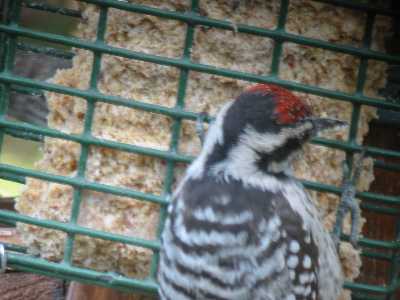 end
of the month-- remarkably, though we think of them as "our"
end
of the month-- remarkably, though we think of them as "our"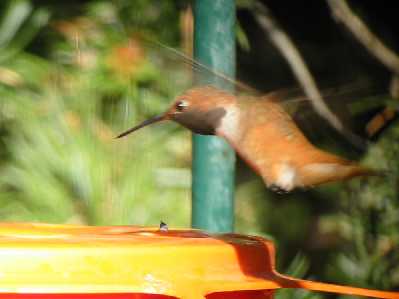 birds, they spend nearly two-thirds
of their lives
in
the neotropics
(as do most of our breeding
vireos,
tanagers and warblers). A few Lark Sparrows appear in yard by
the
last week in July, representing post-breeding wanderers or early
migrants. With luck, monsoons bring afternoon showers before mid-month.
Blue Flax predominates. Acorn crop has not yet ripened, and if rainfall
is scant there is poor forage in the mountains.
birds, they spend nearly two-thirds
of their lives
in
the neotropics
(as do most of our breeding
vireos,
tanagers and warblers). A few Lark Sparrows appear in yard by
the
last week in July, representing post-breeding wanderers or early
migrants. With luck, monsoons bring afternoon showers before mid-month.
Blue Flax predominates. Acorn crop has not yet ripened, and if rainfall
is scant there is poor forage in the mountains. August-- Lark Sparrows (Lower right, on our front "lawn") arrive in good numbers. Juniper Titmouse (upper left, at front waterfall) looks shaggy in molt. Both
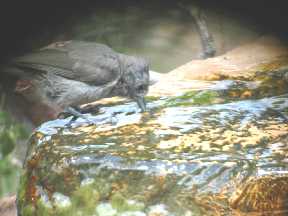 Western Kingbird and , more
commonly, Cassin's
Kingbird (upper
Western Kingbird and , more
commonly, Cassin's
Kingbird (upper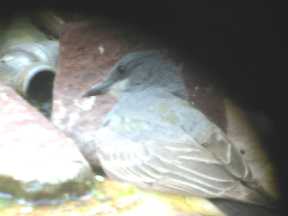 right, also at waterfall) bring
their fledglings to bathe and drink. Blue and Black-headed
Grosbeaks have departed by the end of the month.
Sunflowers
everywhere! Black-throated Gray, Virginia's
(below, center) and Yellow-rumped
Warblers (below left), wandering
after nesting is finished, become more numerous in the trees
and
waterfalls. Lazuli Buntings usually arrive around mid-month.
Orange-crowned Warblers arrive towards the end of the month.
Now
is the best time to see Calliope Hummingbirds at feeders, and the
migrants
that flock to the log at Capulin Spring. Purple Asters and
Blanket Flowers begin to steal the show. If there is a good
piņon
crop, Pinyon Jays
right, also at waterfall) bring
their fledglings to bathe and drink. Blue and Black-headed
Grosbeaks have departed by the end of the month.
Sunflowers
everywhere! Black-throated Gray, Virginia's
(below, center) and Yellow-rumped
Warblers (below left), wandering
after nesting is finished, become more numerous in the trees
and
waterfalls. Lazuli Buntings usually arrive around mid-month.
Orange-crowned Warblers arrive towards the end of the month.
Now
is the best time to see Calliope Hummingbirds at feeders, and the
migrants
that flock to the log at Capulin Spring. Purple Asters and
Blanket Flowers begin to steal the show. If there is a good
piņon
crop, Pinyon Jays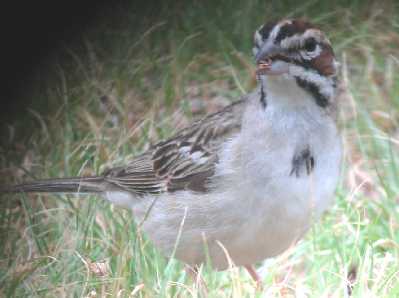
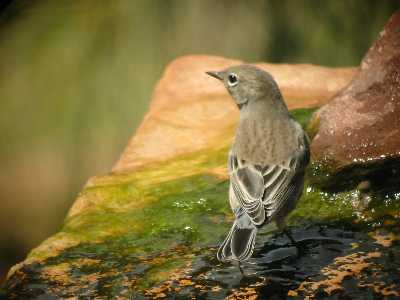 visit in large flocks. American
Robins
become quite scarce, and are seen singly or in groups of only 2 or
3.
visit in large flocks. American
Robins
become quite scarce, and are seen singly or in groups of only 2 or
3. 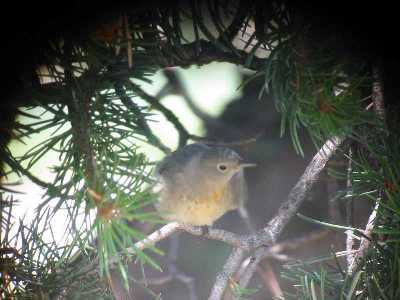
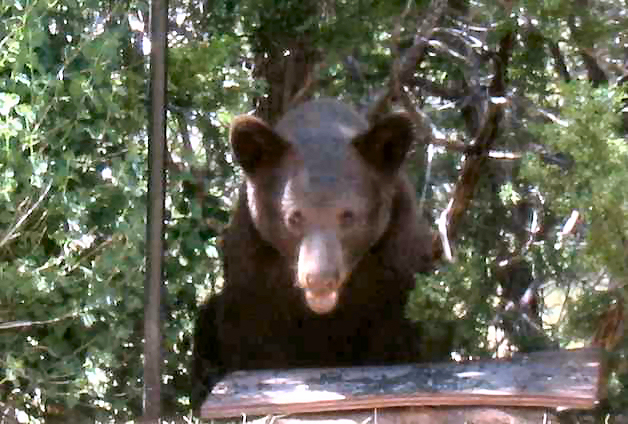 mothers,
begin to
explore our feeders, which we removed from our yard entirely
during bear season.
mothers,
begin to
explore our feeders, which we removed from our yard entirely
during bear season.September-- Monsoons wane. Aspens at the top of the mountain begin turning yellow by the last week, and oaks blaze red. Lesser Goldfinches (male, left) may still be seen feeding fledglings. All three Towhee species (Spotted, Canyon and Green-tailed) may visit our
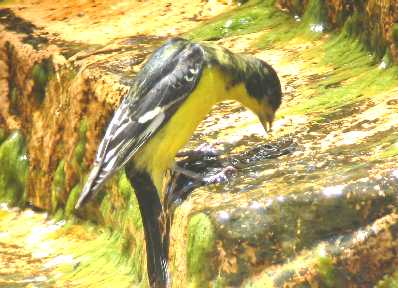 yard
feeders at once. Townsend's Warblers are more common
yard
feeders at once. Townsend's Warblers are more common
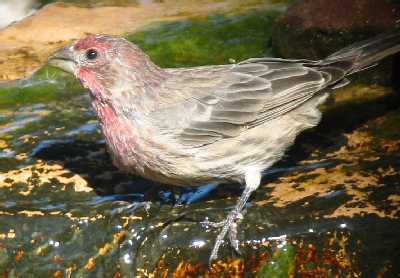 in fall
migration than in the spring. Cassin's
Vireo is possible at
Cienega Picnic Area. Sunflowers bloom everywhere! House Finches (Male, right)
are
molting. Note curved culmen (top edge of upper bill) which
helps
distinguish this species from Cassin's Finch. Bushtits (at middle left and
right)
gather into larger flocks as cold weather approaches. We
enjoyed
watching the antics of our jays. Scrub Jays dominated the
feeders,
chasing away the normally very aggressive Steller's Jays.
This
probably reflects the fact that we lived in the
piņon-juniper belt, and the Stellers were straying from
their
territories in the Ponderosa Pines above our
in fall
migration than in the spring. Cassin's
Vireo is possible at
Cienega Picnic Area. Sunflowers bloom everywhere! House Finches (Male, right)
are
molting. Note curved culmen (top edge of upper bill) which
helps
distinguish this species from Cassin's Finch. Bushtits (at middle left and
right)
gather into larger flocks as cold weather approaches. We
enjoyed
watching the antics of our jays. Scrub Jays dominated the
feeders,
chasing away the normally very aggressive Steller's Jays.
This
probably reflects the fact that we lived in the
piņon-juniper belt, and the Stellers were straying from
their
territories in the Ponderosa Pines above our 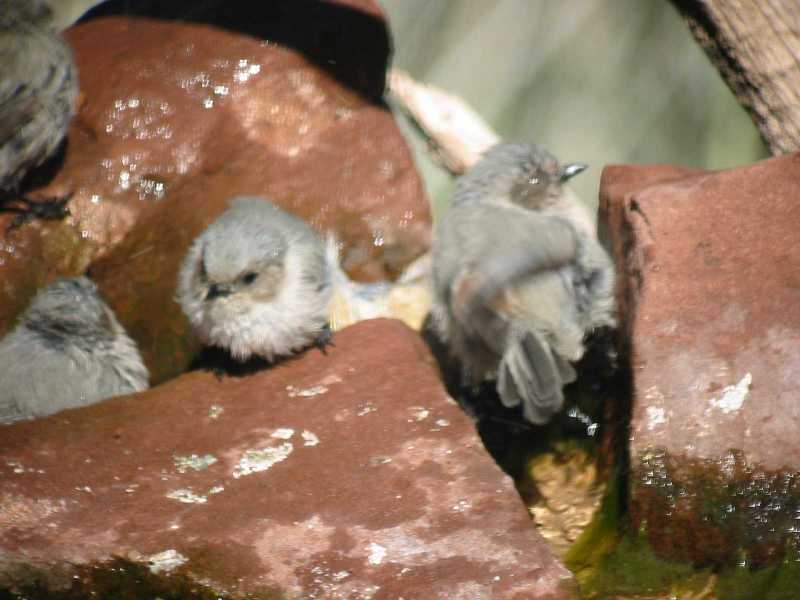
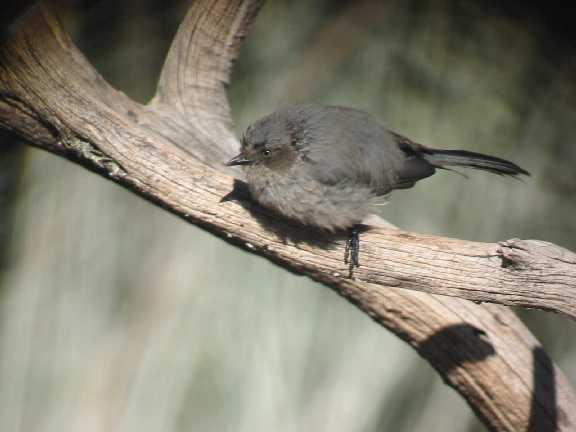 home.
Pinyon Jays have fallen on difficult
times. The extended drought has supressed the
Piņon Pines,
which have not had a good crop since about 1999. That year,
we
had flocks that numbered up to 200 birds nearly completely cover the
snow in our front yard. They could gobble up (or more
properly,
store in their gular pouches and remove) over 2 gallons of black oil
sunflower seed in an hour. I counted over 50 seeds being
taken by
a single Pinyon Jay in one sitting! During the summers of
2002
and 2003 we experienced a huge die-off of Piņon Pines due to
their vulnerability to the Ips bark beetle. We struggled to
save
the 40 or
home.
Pinyon Jays have fallen on difficult
times. The extended drought has supressed the
Piņon Pines,
which have not had a good crop since about 1999. That year,
we
had flocks that numbered up to 200 birds nearly completely cover the
snow in our front yard. They could gobble up (or more
properly,
store in their gular pouches and remove) over 2 gallons of black oil
sunflower seed in an hour. I counted over 50 seeds being
taken by
a single Pinyon Jay in one sitting! During the summers of
2002
and 2003 we experienced a huge die-off of Piņon Pines due to
their vulnerability to the Ips bark beetle. We struggled to
save
the 40 or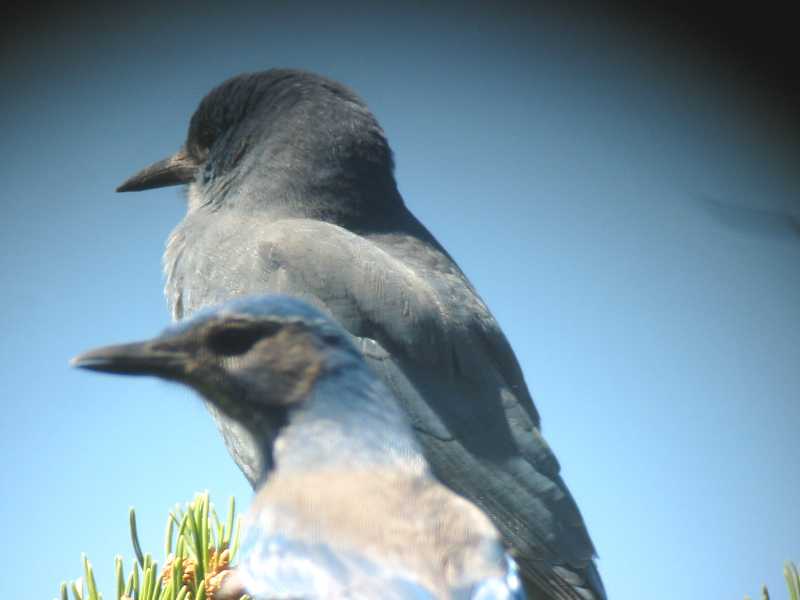
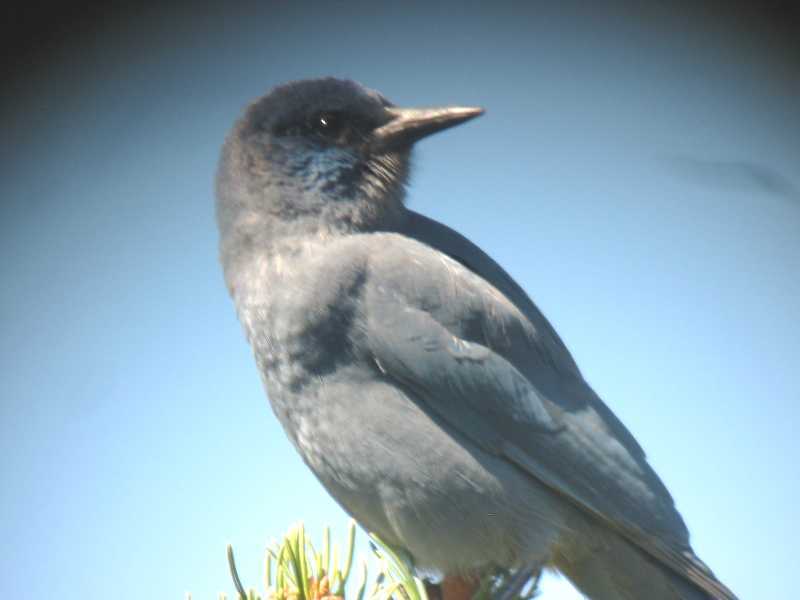 so
on our property by importing water from another aquifier and soaking
the roots of those nearest our home. Not a single Pinyon Jay
visited during the winter of 2002-3. Early in September a few
small flocks made brief foraging visits, as if checking on the progress
of the crop. Only a few of our piņons developed
good
cones, and I was surprised when, on September 19, 2003 a flock of about
20 Pinyon Jays descended noisily and began removing the still closed
and 3/4 grown cones from the tree in front of our home. Three
Scrub Jays joined them, but the Scrubs did not feed-- they just looked
at the Pinyon Jays as they harvested the cones. They did not
pillage any of the
so
on our property by importing water from another aquifier and soaking
the roots of those nearest our home. Not a single Pinyon Jay
visited during the winter of 2002-3. Early in September a few
small flocks made brief foraging visits, as if checking on the progress
of the crop. Only a few of our piņons developed
good
cones, and I was surprised when, on September 19, 2003 a flock of about
20 Pinyon Jays descended noisily and began removing the still closed
and 3/4 grown cones from the tree in front of our home. Three
Scrub Jays joined them, but the Scrubs did not feed-- they just looked
at the Pinyon Jays as they harvested the cones. They did not
pillage any of the 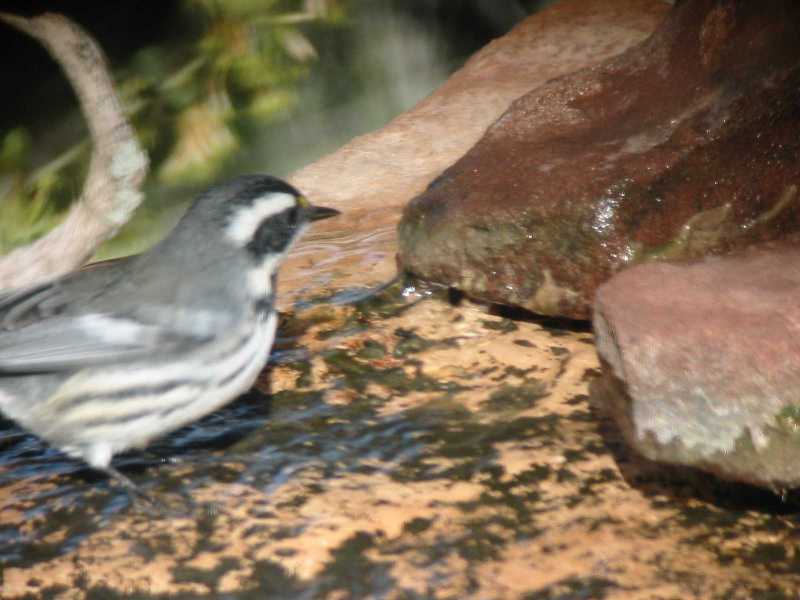
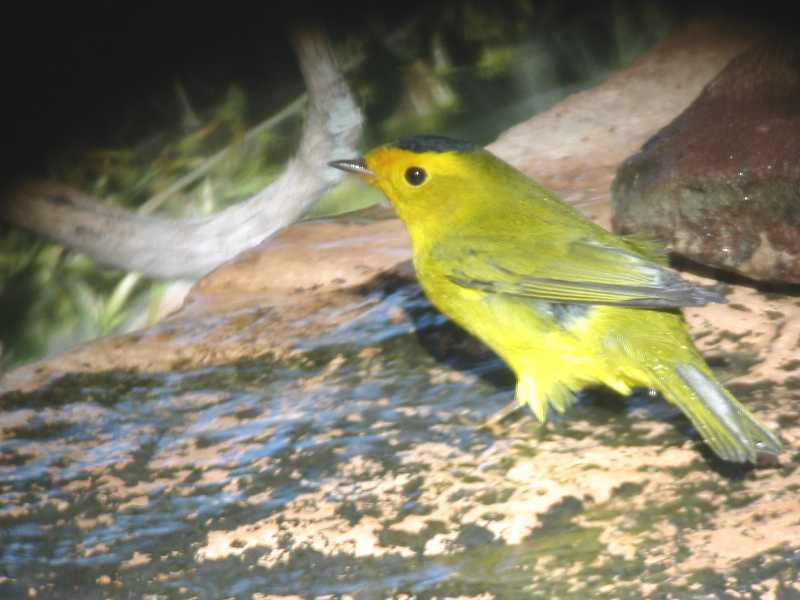 cones,
but stood close by and seemed to be curious
about what was going down. I took several photos of the Pinyon Jays (immature with
grayish plumage
and bright blue on face, left, lower), and just happened
to
catch a Scrub Jay that
was perched
near one of them, providing a nice comparison of face and bill features
(lower right image). Both Wilson's
Warbler (male, bottom left) and Black-throated Gray Warblers (male,
bottom right) visited on September 25, 2003, just as our
fall
wildflowers reached their peak. Be sure to click the
thumbnails
for
expanded views.
cones,
but stood close by and seemed to be curious
about what was going down. I took several photos of the Pinyon Jays (immature with
grayish plumage
and bright blue on face, left, lower), and just happened
to
catch a Scrub Jay that
was perched
near one of them, providing a nice comparison of face and bill features
(lower right image). Both Wilson's
Warbler (male, bottom left) and Black-throated Gray Warblers (male,
bottom right) visited on September 25, 2003, just as our
fall
wildflowers reached their peak. Be sure to click the
thumbnails
for
expanded views.October-- Rabbitbrush and snakeweed combine with aspens to turn the landscape to gold. Light freeze by mid-month, hard freeze and usually first significant snowfall before month's end. Visit Hawk Watch in the Manzano Mountains, and see Northern Goshawk and huge elk herds at the new
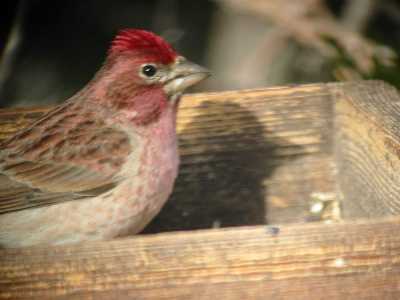 Valles
Caldera
National Preserve
(CLICK HERE AND BE SURE TO CHECK THE MAPVIEWER) in
the Jemez Mountains.
Valles
Caldera
National Preserve
(CLICK HERE AND BE SURE TO CHECK THE MAPVIEWER) in
the Jemez Mountains. 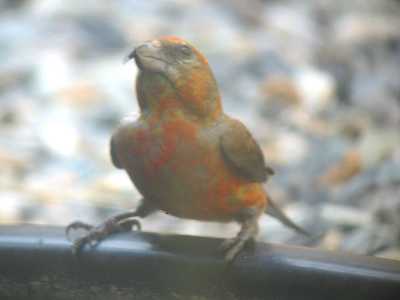
Look for American Three-toed Woodpeckers at the Dome Burn in the Jemez before the roads are snow-bound. Good-bye to the hummers and the Band-tails. Pygmy Nuthatches and Bushtits have assembled into larger flocks. White-crowned Sparrows and Juncos arrive in droves. Hope for Evening Grosbeak, Cassin's Finch (male, upper left, at front
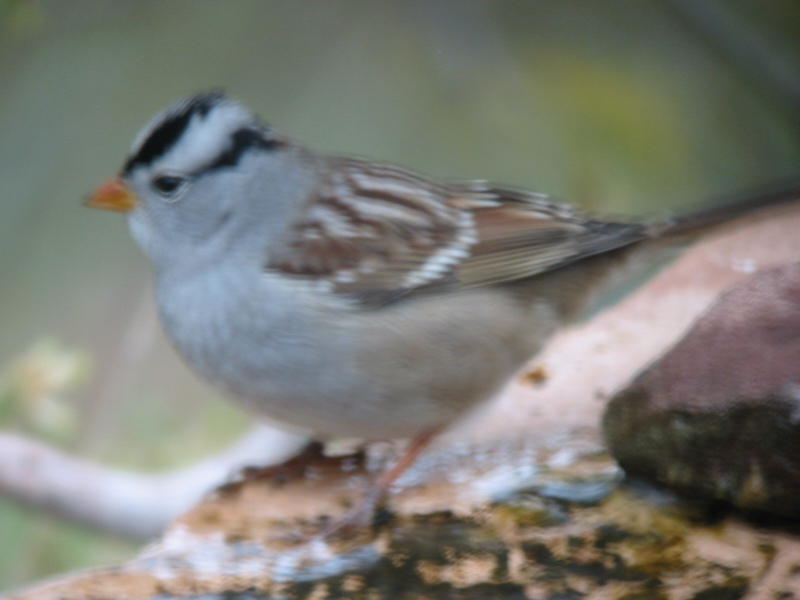
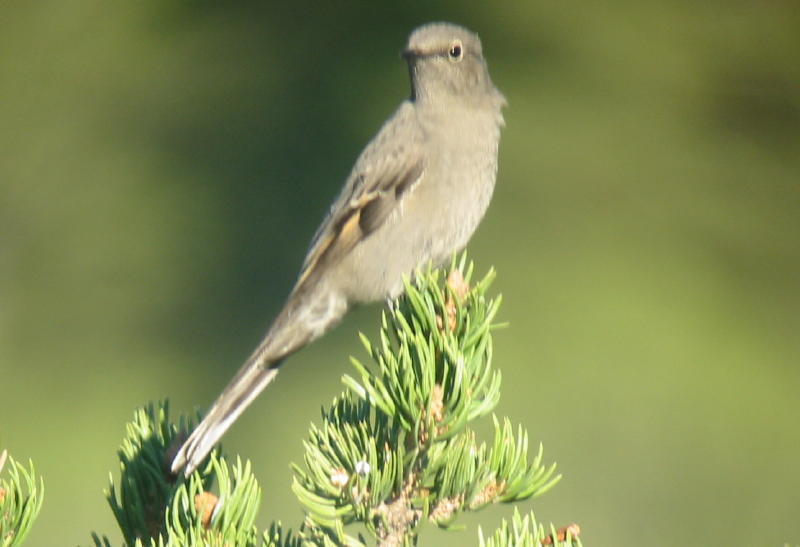 feeder).Red
Crossbill (male, upper right,
at back pool). As the month progresses,
Townsend's
Solitaire (center left, on treetop in front of house) arrive
to
enliven us with their songs, which grow ever brighter with the approach
of winter. White-crowned
Sparrows (right, at front waterfall) arrive and a few will
stay
through the winter. We were delighted to see a Williamson's Sapsucker (adult
female, lower
left) visit
feeder).Red
Crossbill (male, upper right,
at back pool). As the month progresses,
Townsend's
Solitaire (center left, on treetop in front of house) arrive
to
enliven us with their songs, which grow ever brighter with the approach
of winter. White-crowned
Sparrows (right, at front waterfall) arrive and a few will
stay
through the winter. We were delighted to see a Williamson's Sapsucker (adult
female, lower
left) visit 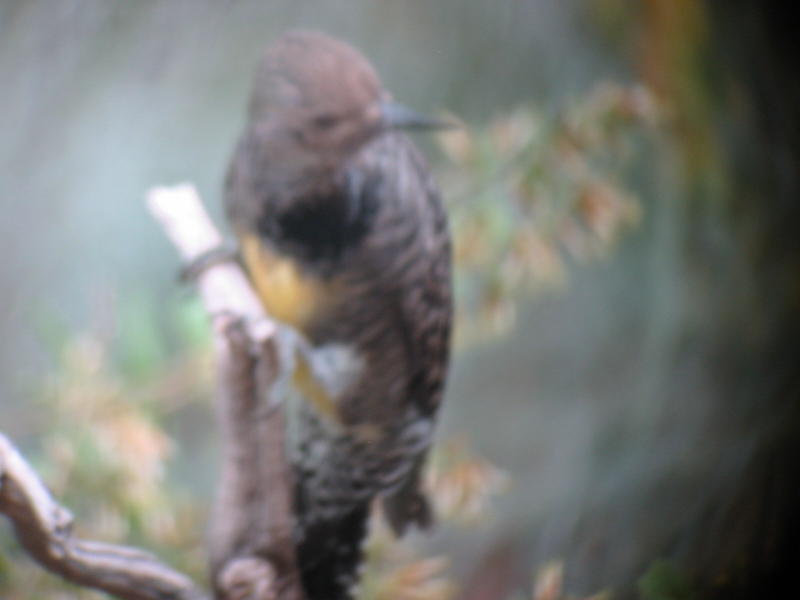 our
front waterfall on October 8, 2003. My photo is of very poor
quality, as the bird flew off before I could get set up for the
shot. Click on it to confirm the ID (just like real live
birding-- that "Marty Stouffer view" is hard to come by! But
see
what happened next month). Once the
cold drives the bears into hibernation, we can put up the yard feeders
again.
our
front waterfall on October 8, 2003. My photo is of very poor
quality, as the bird flew off before I could get set up for the
shot. Click on it to confirm the ID (just like real live
birding-- that "Marty Stouffer view" is hard to come by! But
see
what happened next month). Once the
cold drives the bears into hibernation, we can put up the yard feeders
again.November--Rosy-Finch feeders are put up at Sandia Crest early in the month. We placed stock tank
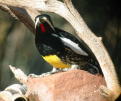 heaters
in the yard ponds and prayed for snow! Checked Santa Fe Ski
Area for
heaters
in the yard ponds and prayed for snow! Checked Santa Fe Ski
Area for White-winged Crossbill and
Pine Grosbeak. Got down to Bosque del Apache
for Festival of the Cranes. Patience was rewarded when a
colorful
adult male Williamson's
Sapsucker
(two views to capture several field marks) visited our
front
yard pond on November 2, 2003. This time I was able
to take
several pictures before it was chased off the waterfall by a
robin. Click on the pictures to appreciate the contrast and
brilliance of its plumage.
White-winged Crossbill and
Pine Grosbeak. Got down to Bosque del Apache
for Festival of the Cranes. Patience was rewarded when a
colorful
adult male Williamson's
Sapsucker
(two views to capture several field marks) visited our
front
yard pond on November 2, 2003. This time I was able
to take
several pictures before it was chased off the waterfall by a
robin. Click on the pictures to appreciate the contrast and
brilliance of its plumage. December-- All three species of Rosy-Finches should arrive at Sandia Crest by the first week.

 Expect
two or three large flocks including as many as 100
individuals; plumage brightens as winter progresses.
Christmas
Bird Counts. Will this be a Townsend's Solitaire/Cassin's
Finch/Red Crossbill/Evening Grosbeak Year, or
some combination thereof?
Expect
two or three large flocks including as many as 100
individuals; plumage brightens as winter progresses.
Christmas
Bird Counts. Will this be a Townsend's Solitaire/Cassin's
Finch/Red Crossbill/Evening Grosbeak Year, or
some combination thereof? 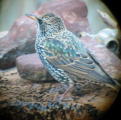
 American
Crow (upper left), and Canyon Towhee (lower left) are
present
all year round.
Male Northern
(Red-shafted) Flicker (upper right) has
a red moustache,
while its eastern Yellow-shafted counterpart has a black one.
Starlings (Lower
right) were rare
in our neighborhood until 2 years ago, when a pair took over a Kestrel
box across the street.
American
Crow (upper left), and Canyon Towhee (lower left) are
present
all year round.
Male Northern
(Red-shafted) Flicker (upper right) has
a red moustache,
while its eastern Yellow-shafted counterpart has a black one.
Starlings (Lower
right) were rare
in our neighborhood until 2 years ago, when a pair took over a Kestrel
box across the street.| Birding is
a
fascinating, exciting, challenging game. It requires and
encourages ever-growing skill. It may involve us in great
adventures and wide travel, sometimes in difficult terrain.Seeking new
birds to check off on our life lists may draw us further into the lives
of these birds, challenging us to learn more about their life cycles,
their behaviors, and ecology; and as our ecological perspectives
expand, we may be stimulated to become more involved in conservation
work, to protect the habitats of the many species we enjoy. (Burton S.
Guttman, Birding,
February
2004) |
Birds
seen in our yard and
adjacent property,
Ventana del Sol Subdivision,
at 7000 feet elevation, between 1993 and May, 2003.
Click
here for some arrival
and departure dates.
| SPECIES |
NESTS |
SPRING |
SUMMER |
FALL |
WINTER |
|---|---|---|---|---|---|
| Great Blue Heron | N | U | - | U | - |
| Snow Goose | N | FL | - | FL | - |
| Mallard | ? | L | L | L | L |
| Blue-winged
Teal |
N |
? |
- |
FL |
- |
| Turkey Vulture | Y | C | C | C | - |
| Golden Eagle | Y(H) | U | R | U | R |
| Northern Harrier | N | I | - | I | U |
| Sharp-shinned Hawk | Y | U | R | U | U |
| Cooper's Hawk | Y* | C | U | C | U |
| Northern Goshawk | Y(H) | R | R | R | R |
| Red-tailed Hawk | Y* | C | C | C | C |
| Ferruginous Hawk | N | R | - | R | - |
| American Kestrel | Y* | C | C | C | C |
| Merlin | N | I | - | I | R |
| Prairie Falcon | ? | I | R | I | I |
| Northern Bobwhite | N** | I | I | I | I |
| Ring-necked Pheasant | N** | I | I | I | I |
| SPECIES | NESTS | SPRING | SUMMER | FALL | WINTER |
| Band-tailed Pigeon | Y(H) | C | C | C | - |
| Rock Pigeon | Y* | A | A | A | A |
| Mourning Dove | Y* | C | C | A | R |
| White-winged Dove | N | I | - | I | - |
| Greater Roadrunner | Y* | L | L | L | L |
| Great Horned Owl | Y* | C | C | C | C |
| Western Screech-Owl | Y | R | R | R | R |
| Common Nighthawk | Y | C | C | U | - |
| Black-chinned Hummingbird | Y | C | C | C | - |
| Calliope Hummingbird | N | I | U | U | - |
| Broad-tailed Hummingbird | Y* | A | A | A | - |
| Rufous Hummingbird | N | I | C | A | - |
| Northern Flicker | Y* | C | C | C | A |
| Lewis's Woodpecker | N | L | L | R | - |
| Williamson's Sapsucker | Y(H,L) | L | L | L | R |
| Red-naped Sapsucker | Y | L | L | L | L |
| Downy Woodpecker | Y | U | U | U | U |
| Hairy Woodpecker | Y* | C | C | C | C |
| Ladder-backed Woodpecker | Y* | C | C | U | U |
| SPECIES | NESTS | SPRING | SUMMER | FALL | WINTER |
| Western Kingbird | Y | U | U | U | - |
| Cassin's Kingbird | Y* | U | U | U | - |
| Ash-throated Flycatcher | Y* | C | C | U | - |
| Olive-sided Flycatcher | Y | U | I | U | - |
| Western Wood-Pewee | Y | U | U | C | - |
| Say's Phoebe | Y* | C | C | C | - |
| Gray Flycatcher | Y | U | R | U | - |
| Cordilleran Flycatcher | Y | C | U | U | - |
| Violet-green Swallow | Y* | C | C | C | - |
| Cliff Swallow | Y | R | R | R | - |
| Barn Swallow | Y | C | C | C | - |
| Western Scrub Jay | Y* | A | A | A | A |
| Pinyon Jay | Y(H) | C | C | A | A |
| Blue Jay | N | I | I | I | - |
| Steller's Jay | Y* | C | C | C | C |
| Clark's Nutcracker | Y(L,H) | U | L | U | U |
| American Crow | Y* | A | A | A | A |
| Common Raven | Y | C | C | C | C |
| Juniper Titmouse | Y* | C | C | C | C |
| SPECIES | NESTS | SPRING | SUMMER | FALL | WINTER |
| Mountain Chickadee | Y* | A | A | A | A |
| Bushtit | Y* | C | C | C | C |
| Brown Creeper | Y(H,L) | U | L | U | R |
| White-breasted Nuthatch | Y* | C | C | C | C |
| Red-breasted Nuthatch | Y(H) | U | U | U | C |
| Pygmy Nuthatch | Y(H) | L |
L | L | L |
| House Wren | Y(H) | L | L | L | - |
| Bewick's Wren | Y | C | C | C | R |
| Ruby-crowned Kinglet | Y(H,L) | C | L | C | R |
| Western Bluebird | Y* | C | C | C | U |
| Townsend's Solitaire | Y(H) | C | L | C | C |
| Hermit Thrush | Y(H) | L | L | L | R |
| American Robin | Y* | A | C | C | U |
| Northern Mockingbird | Y* | U | U | U | R |
| Sage Thrasher | N | R | - | R | R |
| Curve-billed Thrasher | Y | R | R | R | R |
| Cedar Waxwing | N | I | I | R | I |
| SPECIES | NESTS | SPRING | SUMMER | FALL | WINTER |
| European Starling | Y* | A | A | A | A |
| Plumbeous Vireo | Y(L) | U | L | U | - |
| Cassin's Vireo |
N |
I |
- |
U |
- |
| Warbling Vireo | Y(H) | C | L | C | - |
| Orange-crowned Warbler | Y(H) | U | U | C | - |
| Virginia's Warbler | Y* | C | C | C | - |
| Yellow-rumped Warbler | Y(H) | C | L | C | R |
| Black-throated Gray Warbler | Y* | C | L | C | - |
| Townsend's Warbler | N | R | - | C | - |
| Grace's Warbler | Y(H) | C | C | U | - |
| Wilson's Warbler | N | C | - | C | - |
| Hooded Warbler | N | I | - | I | - |
| Rose-breasted Grosbeak | N | R | - | R | - |
| Black-headed Grosbeak | Y* | C | C | C | - |
| Blue Grosbeak | Y* | C | C | C | - |
| Indigo Bunting | Y(L) | R | L | R | - |
| Lazuli Bunting | Y* | U | I | I | - |
| Green-tailed Towhee | Y(H) | R | L | R | R |
| Spotted Towhee | Y* | C | A | C | C |
| SPECIES | NESTS | SPRING | SUMMER | FALL | WINTER |
| Canyon Towhee | Y* | A | A | A | A |
| Lark Sparrow | Y(L) | U | L | C | - |
| Song Sparrow |
? |
R |
- |
R |
- |
| Chipping Sparrow | Y* | C | C | A | R |
| Dark-eyed Junco Gray-headed race Oregon/Pink-sided races Slate-colored race White-winged race |
Y(H) N N N |
C U - - |
I - - - |
A U - - |
A A R R |
| White-throated Sparrow | N | R | - | R | R |
| White-crowned Sparrow | N | U | - | C | U |
| Golden-crowned Sparrow | N | I | - | R | R |
| Fox Sparrow | N | I | - | I | I |
| Lincoln's Sparrow | N | R | - | R | - |
| Western Meadowlark | Y* | C | C | C | R |
| Red-winged Blackbird | N | I | I | I | - |
| Brewer's Blackbird | Y(L) | R | L | R | - |
| Brown-headed Cowbird | Y* | C | C | U | - |
| SPECIES | NESTS | SPRING | SUMMER | FALL | WINTER |
| Common Grackle | N | I | - | I | - |
| Scott's Oriole | N(L) | R | L | R | - |
| Baltimore Oriole | N | R | - | R | - |
| Bullock's Oriole | Y* | C | U | U | - |
| Western Tanager | Y | C | C | U | - |
| Summer Tanager | N | R | - | R | - |
| Hepatic Tanager | Y(H) | U | U | U | - |
| House Sparrow | Y | C | C | C | C |
| Pine Siskin | Y | A | C | A | A |
| American Goldfinch | N | U | - | C | R |
| Lesser Goldfinch | Y | C | C | C | R |
| Red Crossbill | Y(H) | I | R | I | I |
| Cassin's Finch | Y(H) | U | L | U | U |
| House Finch | Y* | A | A | A | A |
| Evening Grosbeak | Y(H) | U | L | U | R |
| SPECIES |
NESTS |
SPRING
|
SUMMER |
FALL
|
WINTER |
---------------------------
Species Count: 120
---------------------------
Key to Abundance on East Slopes of Sandia Mountains by Season:Species Count: 120
---------------------------
[A]bundant and easy to find, [C]ommon in the right habitat, [U]ncommon but usually can be found, [R]are and may not be seen every year, [I]rregular and may not be seen most years , [FL]yover, [L]ocally common elsewhere in Sandia Mtns, e.g., near nesting territory. [-] No data.
Nests in East Sandias? [Y]es, [N]o, [?] not sure, [F]ormerly, [H]igh elevation, above 7000 feet; (L)ocally restricted.
* = observed nesting on or near Ventana del Sol
** = introduced species, probably escaped from local breeders
Photos
and content
copyright 2002, 2003, 2004 Ken and Mary Lou Schneider
Look for target species and directions to birding spots in the Sandias and nearby New Mexico (e.g., "pygmy-owl" or "Capulin Spring"):
Look for target species and directions to birding spots in the Sandias and nearby New Mexico (e.g., "pygmy-owl" or "Capulin Spring"):
|
Search
this site powered by FreeFind |
|
|
| Rosy-Finches at
Sandia Crest |
Birding the
Sandia Mountains |
Ken
Schneider's
Home Page |
Birding the
Manzano and Manzanita Mountains |
E-mail: Ken and Mary Lou Schneider


